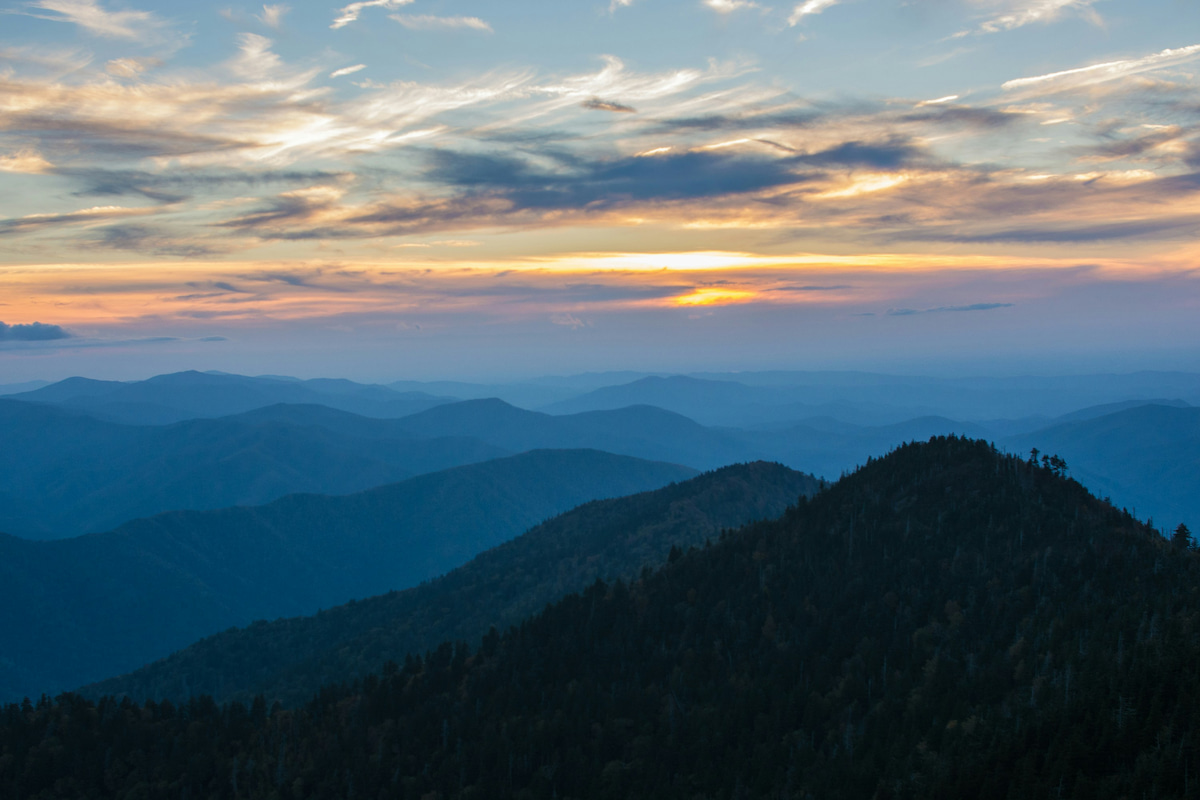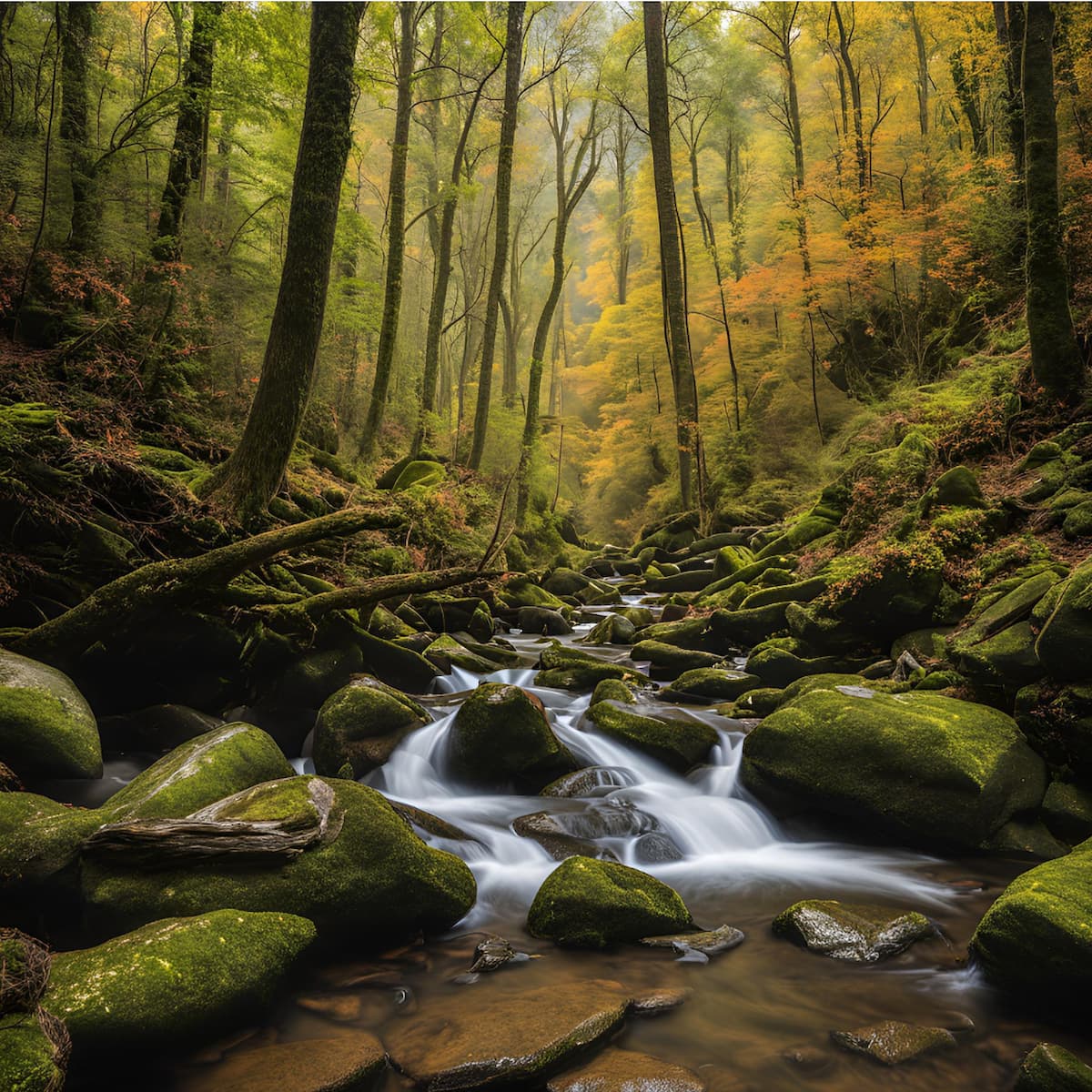
Watch short for this article (5 slides)
Smoky Mountains Majesty: Exploring America's Most Visited National Park
Straddling the border of North Carolina and Tennessee, Great Smoky Mountains National Park reigns as the most visited national park in the United States, drawing millions each year to its mist-shrouded peaks, ancient forests, and unparalleled biodiversity. It's a realm of hazy blue ridges, cascading waterfalls, rich Appalachian culture, and an ecological richness that has earned it designation as an International Biosphere Reserve and a UNESCO World Heritage Site. Far more than just stunning scenery, the Smokies offer a deep dive into geological time, ecological complexity, and the story of American conservation.

Photo by Chris Ried on Unsplash - The iconic misty layers give the Smoky Mountains their name.
Ancient Mountains, Rich History
The Great Smoky Mountains are part of the ancient Appalachian Mountain chain, among the oldest mountains on Earth. Formed hundreds of millions of years ago during continental collisions that assembled the supercontinent Pangaea, their rounded peaks and deep valleys tell a story vastly different from the jagged, younger ranges of the American West. Unlike many other mountain ranges, the highest elevations of the Smokies were largely spared from the scouring effects of recent ice ages (though glaciers reached nearby areas), allowing them to serve as a crucial biological refuge. This geological stability over immense timescales is a key factor contributing to the park's extraordinary biodiversity.
Long before European settlement, this land was the ancestral home of the Cherokee people, who inhabited the region for thousands of years, developing a rich culture deeply intertwined with the mountains they called "Shaconage" (Land of Blue Smoke). European-American settlers began arriving in the late 18th and early 19th centuries, establishing communities based on logging and small-scale farming throughout the coves and valleys.
The creation of the park itself was a complex and unique process. Unlike many western parks established from existing federal lands, Great Smoky Mountains National Park was pieced together primarily from privately owned land – farms, homesteads, and logging company tracts. This required significant fundraising efforts by dedicated citizens in both North Carolina and Tennessee, major philanthropic contributions (notably from John D. Rockefeller Jr.), and federal assistance. The process involved contentious land acquisition and the displacement of established communities. The park was officially established on June 15, 1934, and formally dedicated by President Franklin D. Roosevelt in 1940, preserving this remarkable landscape for future generations.
An Oasis of Biodiversity
Great Smoky Mountains National Park is renowned as a global center of biodiversity, particularly for temperate zone ecosystems. Several factors contribute to this richness:
- Ice Age Refuge: Serving as a refuge during past ice ages allowed numerous plant and animal species to persist here when they were wiped out further north.
- Elevation Gradient: The park boasts a significant elevation range, from roughly 875 feet (267 m) to 6,643 feet (2,025 m) at Clingmans Dome, creating diverse microclimates and habitats akin to traveling from Georgia to Maine.
- Abundant Rainfall: High precipitation levels, especially at higher elevations which can receive over 85 inches (216 cm) annually, support lush vegetation and numerous streams.
- Geographical Position: Its location facilitates the overlap of northern and southern species ranges.
This results in staggering numbers:
- Trees: Over 100 species of native trees, more than in all of northern Europe, forming some of the finest examples of deciduous hardwood forest remaining globally.
- Flowering Plants & Ferns: More than 1,600 species of flowering plants and abundant ferns thrive here.
- Salamanders: The park is often called the "Salamander Capital of the World," harboring around 30 species, making it a global hotspot for salamander diversity.
- Mammals: Approximately 65 species, including a high density of American black bears.
- Birds: Over 240 species regularly sighted.
- Undiscovered Life: Scientists estimate that tens of thousands of species, particularly fungi, insects, and other invertebrates, may still await discovery within the park's boundaries. (Source: NPS - GSMNP Nature & Science)

The park is famous for its healthy population of American black bears.
The Signature "Smoke": Unraveling the Haze
The park's name derives from the characteristic blueish haze that often settles over the mountains, resembling smoke. This isn't pollution (though modern pollutants can exacerbate it), but a natural phenomenon resulting from:
- Volatile Organic Compounds (VOCs): The dense vegetation, particularly conifers, releases natural VOCs into the atmosphere.
- Humidity: High humidity levels are common due to abundant rainfall and transpiration from plants.
- Chemical Reactions: VOCs react with moisture and ozone in the atmosphere, scattering blue light from the sky and creating the signature hazy appearance. The Cherokee name, "Shaconage," reflects this natural condition.
Exploring the Smokies: Highlights and Activities
With over half a million acres, the park offers diverse experiences:
- Scenic Drives:
- Newfound Gap Road (US-441): Climbs over 5,000 feet, crossing the park's main crest and offering numerous overlooks with stunning mountain vistas.
- Cades Cove Loop Road: An 11-mile, one-way paved loop through a beautiful, historic valley. Excellent for wildlife viewing (deer, bear, turkey are common) and exploring preserved homesteads, churches, and a grist mill from the 19th-century Appalachian community. Allow several hours due to slow traffic, especially during peak season.
- Roaring Fork Motor Nature Trail: A narrow, winding loop drive near Gatlinburg offering access to historic buildings, waterfalls, and dense forests (seasonal access, vehicles over 25 feet and trailers prohibited).
- Hiking: Over 850 miles of trails cater to all abilities.
- Appalachian Trail (AT): Approximately 71 miles of the famed AT traverse the park's crest, including strenuous climbs and spectacular ridge walking.
- Popular Day Hikes: Alum Cave Bluffs Trail (moderate, leading to impressive bluffs), Chimney Tops Trail (strenuous, recently reopened with a new overlook after fire damage), Laurel Falls Trail (easy, paved, leads to a popular waterfall), Grotto Falls Trail (moderate, hike behind the waterfall), Abrams Falls Trail (moderate, in Cades Cove, leads to a voluminous waterfall).
- Clingmans Dome: At 6,643 feet, it's the highest point in the park and Tennessee. A steep, paved 0.5-mile trail leads to a distinctive spiral observation tower offering (on clear days) 360-degree views potentially spanning over 100 miles across multiple states. Note: Air pollution/haze can often limit visibility.
- Waterfalls: Beyond those mentioned above, numerous cascades and waterfalls reward hikers throughout the park.
- Wildflower Viewing: Spring (late March through May, depending on elevation) brings spectacular displays, earning the park the nickname "Wildflower National Park." Annual Spring Wildflower Pilgrimage event celebrates this.
- Historical Exploration: Explore preserved log cabins, barns, churches, and mills in areas like Cades Cove, Oconaluftee, Cataloochee, and along the Roaring Fork Motor Nature Trail to understand the region's Appalachian heritage.
A Park for All Seasons
Each season offers a unique perspective on the Smokies:
- Spring: Renowned for its dazzling wildflower displays, starting at lower elevations in March and progressing upwards into June. Waterfalls are often at peak flow.
- Summer: Lush green forests provide shade. Higher elevations offer cooler temperatures. Humidity is typically high. Popular time for hiking and camping.
- Autumn: World-famous for its prolonged and vibrant fall foliage display, typically peaking from mid-October (higher elevations) to early November (lower elevations). Cooler, drier air often brings clearer views.
- Winter: A quieter season offering solitude. Higher elevations receive significant snowfall, closing roads like Clingmans Dome Road and parts of Newfound Gap Road intermittently. Lower elevations may see occasional snow. Offers opportunities for peaceful hikes and observing animal tracks.

Autumn transforms the Smokies into a vibrant tapestry of fall colors.
Conservation Challenges and Stewardship
Despite its protected status, Great Smoky Mountains National Park faces significant environmental challenges:
- Air Pollution: Being downwind of major industrial and urban areas, the park suffers from some of the worst air quality among US national parks, including ground-level ozone and acid deposition (acid rain/fog). This impacts visibility, harms sensitive vegetation (especially high-elevation forests), and affects human health.
- Invasive Species: Numerous non-native species threaten native ecosystems. The Hemlock Woolly Adelgid, an invasive insect, has devastated native Eastern Hemlock trees, crucial components of forest ecosystems. Feral hogs damage vegetation and spread disease. Invasive plants outcompete native flora.
- High Visitation: As the most visited national park (often exceeding 12-14 million visits annually), managing impacts from traffic congestion, crowding, resource strain, and wildlife interactions is a major ongoing challenge.
- Climate Change: Altering temperature and precipitation patterns, potentially affecting species ranges, increasing stress on certain ecosystems (like high-elevation spruce-fir forests), and potentially increasing the frequency or intensity of extreme weather events.
- Forest Health: Legacy impacts of past logging, ongoing threats from pests and diseases, and changing fire regimes require active management.
The National Park Service, often in collaboration with partners like Friends of the Smokies and Discover Life in America (which runs the All Taxa Biodiversity Inventory), works continuously on research, monitoring, restoration, and management efforts to address these complex issues.
Conclusion: An Appalachian Gem
Great Smoky Mountains National Park is a place of profound natural beauty, ecological significance, and rich cultural history. Its ancient, mist-laden mountains harbor an extraordinary diversity of life, offering sanctuary to countless species and providing endless opportunities for human exploration, reflection, and recreation. From the vibrant wildflowers of spring and the lush greenery of summer to the fiery foliage of autumn and the quiet solitude of winter, the Smokies captivate the senses year-round. As the most visited national park, it serves as both a beloved destination and a critical front line for conservation, reminding us of the enduring value of preserving these wild Appalachian landscapes and the intricate web of life they sustain.